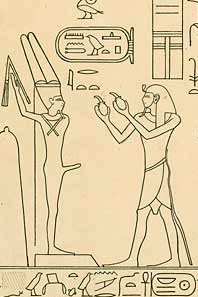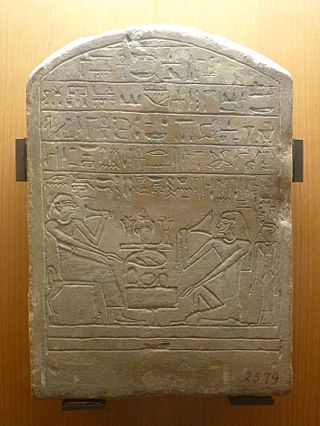
Userkare Khendjer was a minor king of the early Thirteenth Dynasty of Egypt during the Middle Kingdom. Khendjer possibly reigned for four to five years, archaeological attestations show that he was on the throne for at least three or four years three months and five days. Khendjer had a small pyramid built for himself in Saqqara and it is therefore likely that his capital was in Memphis.

Nebtawyre Mentuhotep IV was the last king of the 11th Dynasty in the Middle Kingdom. He seems to fit into a 7-year period in the Turin Canon for which there is no recorded king.

Khaneferre Sobekhotep IV was one of the more powerful Egyptian kings of the 13th Dynasty, who reigned at least eight years. His brothers, Neferhotep I and Sihathor, were his predecessors on the throne, the latter having only ruled as coregent for a few months.

Sekhemre Khutawy Amenemhat Sobekhotep was an Egyptian pharaoh of the early 13th Dynasty in the late Middle Kingdom.

Sekhemre Sewadjtawy Sobekhotep III was an Egyptian king of the mid Thirteenth Dynasty of Egypt who reigned three to four years.

Iymeru Neferkare was the ancient Egyptian vizier under king Sobekhotep IV in the 13th Dynasty, in the Second Intermediate Period.

Aya was an ancient Egyptian king's wife of the early Thirteenth Dynasty.

Senebi was an ancient Egyptian treasurer under the late 13th Dynasty kings Neferhotep I and Sobekhotep IV. Senebi belongs to the best attested officials of the 13th Dynasty.
The Papyrus Boulaq 18 is an ancient Egyptian administrative document. It contains an account of the Theban palace dating to the 13th Dynasty. The papyrus lists the palace officials and the rations they received day by day. Important officials mentioned are, for example, the vizier Ankhu, but also the queen Aya. Therefore, the document is of great historical importance. It also reports the journey of the king to the temple at Medamud and reports the arrival of a delegation of Nubians.

Senewosret-Ankh {s-n-wsrt-ꜥnḫ/snfrw} was an ancient Egyptian vizier of the Middle Kingdom, dating to the end of the Twelfth or to the beginning of the Thirteenth Dynasty.

Zamonth or Samont was an ancient Egyptian vizier who is thought to have been in office during the reign of Amenemhat III, at the end of the Twelfth Dynasty.
This page list topics related to ancient Egypt.
Minemhat was an Ancient Egyptian mayor of Koptos during the 17th Dynasty in the late Second Intermediate Period. Minemhat appears in three sources and served during the reign of Nubkheperre Intef.
Sobeknakht I was an ancient Egyptian official of the Second Intermediate Period. He was the local governor at Elkab.

Aabeni was an ancient Egyptian official with the title high steward. He was one of the most important officials at the royal court in the early Thirteenth Dynasty.

Seneb was an ancient Egyptian living in the Thirteenth Dynasty about 1750 BC. He is known from a number of sources around king Sobekhotep III, who was his brother. The father of Seneb was the god's father Mentuhotep, his mother was the king's mother called Iuhetibu. Seneb bears the title king's son, although he was not the son of a king. In the Thirteenth Dynasty the title king's son was often used as title of honor and did not automatically mean that the title bearer was the son of a king. Seneb's own family is known from a stela now in Vienna. His wife was called Nebtit and their children were:
Dedusobek Bebi was a high official of the late Thirteenth Dynasty of ancient Egypt. He became the "Great Scribe of the Vizier". This position was directly under the Vizier acting as a deputy.
Resseneb was a short-lived vizier in Upper Egypt during the 13th Dynasty, preceded by his father, the famous Ankhu, and succeeded by his brother Iymeru.
The Brooklyn Papyrus 35.1446, also known as simply the Papyrus Brooklyn, is an ancient Egyptian document now in the Brooklyn Museum.

Amenyseneb was the Controller of a Phyle or Regulator of a Watch at Abydos during the early 13th Dynasty in the late Middle Kingdom of Egypt. While he was an official of lower rank, his attestations binds important persons like king Khendjer and vizier Ankhu in time.














